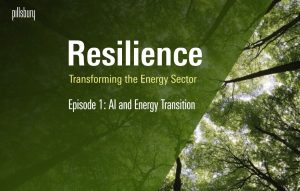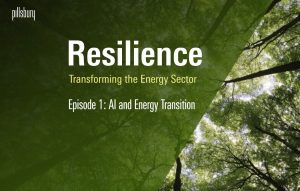 Colleague and host Shellka Arora-Cox not too long ago sat down with Sandhya Ganapathy, CEO of EDP Renewables North America, to debate the fascinating intersection of the vitality transition and synthetic intelligence.
Colleague and host Shellka Arora-Cox not too long ago sat down with Sandhya Ganapathy, CEO of EDP Renewables North America, to debate the fascinating intersection of the vitality transition and synthetic intelligence.
(Editor’s observe: The next transcript has been edited for readability.)
From the guts of India, resilience has formed who I’m. At the moment, I’m sharing insights from leaders and innovators who’re pushed by the identical energy. Welcome to Resilience, the place we discover how resilience is driving transformation within the vitality sector.
I’m your host, Shellka Arora-Cox, a companion at Pillsbury Winthrop Shaw Pitman. Becoming a member of me immediately is Sandhya Ganapathy, the CEO of EDP Renewables, North America. Sandhya and I shall be exploring the fascinating intersection of vitality transition and synthetic intelligence (AI). Sandhya, welcome.
Sandhya Ganapathy: Thanks a lot, and I’m completely trying ahead to the dialog.
Arora-Cox: Earlier than we dive into the main points of vitality transition and AI, may you speak just a little about the way you discovered your self on the helm of EDP Renewables?
Ganapathy: Positive. My journey with renewables began about 13 years in the past after I joined EDP. Earlier than that, I used to be an funding banker. I cherished banking, however I used to be at a degree in my profession the place I wished to maneuver to the shopper facet and do one thing extra purpose-driven. At the moment, my household and I moved to Houston, and renewables was nonetheless a younger business. I felt it was an area the place I may have an effect, not solely due to my background but in addition as a result of it aligned with my perception that companies and communities can coexist.
I began by main M&A for North America after which for the group as an entire. During the last three years, I’ve been operating North America, and looking out again, I wouldn’t have had it some other means.
Arora-Cox: That’s a fantastic journey. May you give our listeners an outline of the scope and scale of EDP Renewables’ initiatives and your day-to-day work?
Ganapathy: Definitely. EDP Renewables is an built-in unbiased energy producer (IPP) based mostly in Portugal. We’re current in 30 nations, and the U.S. is our largest market, the place we’ve got practically 20 gigawatts of put in capability throughout numerous types of vitality. Our firm is considerably leaning in the direction of renewables, aiming to be coal-free by 2025, absolutely inexperienced by 2030, and net-zero by 2040. We make use of about 13,000 folks globally. In North America, the place we’ve been working for 17 years, we concentrate on onshore and offshore wind, photo voltaic, batteries, and hydrogen. We’ve over 10 gigawatts of working belongings and a crew of 1,100 folks on the bottom.
Arora-Cox: You touched on decarbonization objectives. Do you see AI as the important thing to delivering the vitality we want, or is it simply one other device in our toolkit?
Ganapathy: I wouldn’t categorize AI as simply one other device. In my opinion, AI and vitality are what I’d name an influence couple. The actual problem is making certain this partnership works successfully.
Historically, vitality was extra simple: you had technology, and it was distributed to shoppers. However immediately, the vitality panorama is way extra complicated. We’ve producers who’re additionally shoppers, and the grid must function seamlessly inside this multidimensional surroundings. AI is essential to managing this complexity.
On the demand facet, we’re seeing important will increase in vitality consumption, pushed by elements akin to electrification, manufacturing, and the info wants of AI itself. Whereas vitality effectivity has historically helped offset this development, we at the moment are in a part the place consumption is rising extra quickly. That is the place AI turns into important—not solely in managing demand however in making certain that this elevated consumption aligns with decarbonization objectives.
AI can also be invaluable for renewable vitality firms like EDP. It allows us to function extra effectively by enhancing areas akin to predictive upkeep and diagnostics for our wind farms. AI permits us to optimize efficiency by forecasting climate patterns extra precisely, which is important given the rising unpredictability as a consequence of local weather change. Moreover, AI helps stability the grid, particularly when integrating renewable sources like photo voltaic, wind, and battery storage, making certain fluctuations are managed extra easily.
In brief, AI is way over only a device; it performs a pivotal position in each managing the complexity of vitality methods and driving the transition to cleaner, extra resilient vitality infrastructure.
Arora-Cox: You talked about AI’s potential to assist meet demand. How a lot of that demand do you see being met by renewables? What position do you suppose AI will play in decarbonization?
Ganapathy: AI will play a central position in decarbonization, however it’s not the one issue. I view AI as a key enabler in serving to us meet our decarbonization objectives, however the success of those efforts will rely upon how successfully we combine AI with different methods and applied sciences.
For instance, on the demand facet, we’re seeing a surge in vitality consumption, pushed largely by digital applied sciences like AI itself, information mining, and even actions like Bitcoin mining. Historically, enhancements in vitality effectivity have helped offset rising demand, however we at the moment are getting into an period the place consumption is rising sooner, particularly as industries transfer towards electrification. This elevated demand, if left unchecked, may result in larger emissions—except we deploy renewable vitality at a scale that retains tempo with this consumption.
That is the place AI performs a pivotal position. AI permits us to optimize how we generate, distribute, and retailer vitality, notably from renewable sources. For instance, AI will help us handle intermittent renewable assets, like wind and photo voltaic, by enhancing climate forecasting and optimizing vitality storage. This makes the grid extra resilient and ensures that clear vitality is obtainable when and the place it’s wanted.
Moreover, AI helps firms like EDP function extra effectively. By means of predictive upkeep, diagnostics, and real-time monitoring, AI can be sure that renewable belongings like wind farms and photo voltaic installations are working at peak efficiency. This not solely helps cut back downtime but in addition extends the lifespan of those belongings, contributing to extra sustainable vitality manufacturing.
Nevertheless, AI alone can not clear up all of the challenges of decarbonization. The tempo at which we will deploy renewable vitality initiatives is important. There’s a big hole between the rising demand for electrical energy, pushed partly by AI, and the deployment of renewables. Closing this hole would require robust public-private partnerships, streamlined allowing processes, and coordinated efforts throughout federal companies, utilities, and builders.
So, whereas AI is a robust device in our decarbonization toolkit, its success will rely upon broader structural modifications in how we plan, deploy, and handle vitality infrastructure. The actual problem is making certain that the tempo of renewable vitality deployment matches the rising demand, and AI shall be instrumental in making that occur.
Arora-Cox: You touched on many stakeholders within the sector, and it’s clear that it’s not nearly EDP or any single developer. The U.S. electrical energy grid is among the most complicated machines on the planet, with hundreds of mills linked throughout 600,000 miles of transmission strains—double the space to the moon. How do you see AI and your companions within the sector enjoying a task in enhancing grid resilience?
Ganapathy: That’s a fantastic query, Shellka, and it really emphasizes the complexity of the grid we’re coping with. The U.S. grid is an unlimited, intricate machine, and it wasn’t designed for the vitality panorama we’re in immediately. The upgrades we’ve made over time are minimal, particularly in comparison with the speedy shifts we’re now seeing in how we generate and eat vitality.
I at all times consider an instance: somebody confirmed me a map of Australia’s electrical energy grid, and due to its geography, the grid basically runs in a straight line. In distinction, the U.S. grid is way extra difficult, with hundreds of interconnections and several types of vitality sources feeding into it. AI is completely important in managing this complexity.
At the moment, we’ve got about 1.2 million gigawatts within the system throughout all types of vitality, together with renewables. And what’s within the queue for research and potential deployment is much more—greater than 1.2 million gigawatts. So, over time, we’ve put in an unbelievable quantity of capability, however there’s nonetheless a lot extra within the pipeline.
AI helps us improve grid reliability by enhancing climate forecasting, permitting us to foretell situations extra precisely, right down to the minute. That is particularly essential with the rising unpredictability of climate patterns as a consequence of local weather change. AI additionally helps us combine distributed vitality assets like microgrids and optimize how we distribute energy throughout the grid. Nevertheless, expertise alone gained’t clear up every part. We’d like structural reforms, particularly round long-term transmission planning. FERC’s discussions on long-term planning are encouraging, as they require ISOs and RTOs to consider the following 10, 15 years, which is essential for the way forward for vitality resilience.
This isn’t about politics or ideology. It’s about what’s crucial for the nation to be energy-resilient, safe, and for the financial system to thrive. AI shall be a important device in ensuring our grid can meet the calls for of tomorrow whereas supporting our decarbonization objectives.
Arora-Cox: As a pacesetter on this house, how are you making ready your groups for this ever-evolving vitality panorama?
Ganapathy: One among my core management rules is at all times being ready for the surprising. An excellent instance I typically discuss with is Michael Phelps throughout the 2008 Beijing Olympics, when his goggles slipped throughout one among his races. Regardless of the surprising problem, he nonetheless went on to win the gold medal. This instance speaks to the significance of planning for each attainable situation, even these you wouldn’t anticipate.
In our business, we’ve got to plan for the surprising. I typically inform my crew that it’s not sufficient to only have a Plan A—we want Plans B, C, and even D in place. It’s about being ready for each situation to make sure undertaking certainty and success.
However past planning, an important funding we will make is in our folks. We have to constantly practice and upskill our workforce to allow them to deal with the evolving calls for of the vitality sector. Sooner or later, every of us will move the baton to the following technology, and it’s important that they’re able to take the business even additional.
AI is a key a part of this transformation, and we’re already leveraging it throughout our operations. Whether or not it’s optimizing our belongings or enhancing undertaking administration, we’re always on the lookout for methods to enhance effectivity and innovate. That tradition of innovation is important to our long-term success, and we have to foster it at each degree of the group.
Arora-Cox: Wanting into your crystal ball, what tendencies do you see shaping the vitality sector over the following two to a few years?
Ganapathy: Essentially the most important pattern I foresee is the continued rise in vitality demand. For this development to be sustainable, we should be sure that the areas driving demand additionally see corresponding renewable vitality deployment. Well timed undertaking supply shall be essential, as industries and shoppers alike are betting on renewables to fulfill their wants.
Power storage is one other key space of focus. Whereas storage is already enjoying a big position immediately, I anticipate substantial development. By the top of this 12 months, we count on to see near 40 gigawatts of photo voltaic capability and greater than 10 gigawatts of storage deployed within the U.S. alone. The way forward for storage will contain optimization, notably in shifting past the present normal of four-hour storage to longer-duration options. This evolution will improve grid resilience and reliability.
Moreover, hydrogen is an rising pattern that holds long-term potential. Although the hydrogen sector nonetheless has a approach to go, it’s harking back to the place battery expertise was 10 or 15 years in the past. I’m optimistic that we are going to see important developments, although it’s going to take time earlier than hydrogen turns into commercially viable at scale.
Finally, I’m inspired by the real perception throughout the sector that renewable vitality will proceed to take heart stage. We’re now not on the margins of the vitality combine—renewables now signify round 20%, and we should keep this momentum to attain even better penetration within the years forward. The vitality sector is poised for continued development, and I’m assured that we’ve got the instruments and innovation crucial to fulfill the rising calls for of the long run.
Arora-Cox: Earlier than we shut, what retains you resilient? What makes your work each impactful and satisfying?
Ganapathy: I genuinely love my job, my firm, and the folks I work with. There’s a deep sense of objective that comes with working within the renewable vitality sector. We’re not simply delivering inexperienced electrons to the grid; we’re making an enduring influence on communities. I bear in mind a farmer in Indiana telling me how leasing his land for one among our initiatives helped him ship his kids to varsity. That’s extremely highly effective and serves as a reminder of the broader societal influence we’re having.
For me, resilience comes from understanding that what we’re doing is significant and that it’ll have an enduring optimistic influence on future generations. The work we do immediately will set the inspiration for a extra sustainable and equitable world, and that’s what retains me going.
Arora-Cox: As we wrap up, let’s finish on a lighter observe. Any phrases of knowledge or maybe a quote from Ruskin Bond for our listeners?
Ganapathy: I grew up in India, and like many, I used to be deeply influenced by British authors who lived there, together with Ruskin Bond. One among his quotes that has at all times resonated with me is: “I dream of a backyard, a backyard that’s spacious, flourishing, and aromatic. If I don’t succeed, by no means thoughts, I nonetheless have my dream.” I discover that quote notably significant as a result of it speaks to the resilience required in our sector. Even when issues don’t go our means, it’s essential to carry onto that dream and objective. For anybody getting into the sector and even contemplating it, my recommendation can be to remain centered on the bigger objective. The journey could not at all times be easy, however the dream of constructing a greater, extra sustainable future will take you far.
Arora-Cox: Sandhya, thanks a lot. Could the backyard develop greener and greener. That’s it for immediately. Tune in subsequent time for extra Resilience.






